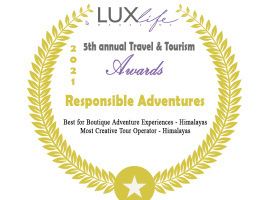Shamanism in Nepal
A recent anthropological study shows that this is not a single universal Shamanism but multiple forms of Shamanism. The diverse types of mediumistic and Shamanistic practices support this argument in Nepal. Even though the nation’s specific ethnic groups can be linked with particular ceremonial and religious traditions, it is beneficial to think of these historic strands as part of the broader Hindu-Buddhist Shamanistic ritual structure. In addition, it is familiar with the hill communities that reflect Nepal’s compound cultural, geographical, and linguistic distinctness.
Large sections such as “spirit mediumship,” spirit possession, and “shamanism” do not do justice to reflect the whole array of ways in which rituals are practised.
In early 2019, I spent a few weeks with a Shaman in East Nepal around 2700 meters to learn more about Shamanism. The village and its never-ending terraces were occupied predominantly by Tamangs. The other Nepalese ethnic groups consisted of Sherpas, Sunuwar Rais, Chettris, and Brahmins in the lower hills.
The Chettri Shamans share several essential traits common with shamans of other ethnic groups, including the utilization of ritualistic paraphernalia and drums. However, the regions “Kul-Dhamis (lineage mediums) serve primarily as vehicles of the Chettri “Kul” patrilineage, and those are different from the ritual practitioners of the other ethnic groups.
Dhami and Jhakri are often used as a single term in Nepal. However, Dhami Jhakri is commonly used conversely to refer to the ceremonial practitioners who are believed to have the ability to manifest local spirits and deities.
The emphasis on metaphysical personification’s embodiment differentiates these practitioners from other religious gurus who either do not desire or cannot connect with spirits. In more extensive anthropological terms, Dhami generally refers to ‘spirit mediums’ or ‘oracles.’ In contrast, Jhakri is usually translated in English as ‘shaman.’ A variant of a ‘Shaman is Bombo, in the Tamang dialect.
In local practice, a Dhami is a person who accomplishes a specific ritual objective. The hyphenated Kul and Jhakri refer to how this purpose is fulfilled; possession by the Kul-Deuta (ancestral deities) in the former instance; while utilizing the Shaman’s equipment helps gain access latter. The insistence on the technique and specific ritual accessories suggests a relevant difference between the Jhakri and Dhami masters.
The significance of the Shamanistic accoutrement as a differentiating indication becomes even more credible. The term Jhakri not only refers to the human practitioner but also characterizes the Shaman’s protective deity.
The ban(forest)-jhakri is a small creature covered in hair and lives in the surrounding forest. It is believed that it is equipped with a drum and shamanistic equipment.
The Landscape of the Spirits
In the hills of Nepal, it is believed that people and spirits walk the same passage. The deities and ghosts reside in the surrounding forests and hills. Faith healing is essential to define society, body, and spirit interconnection. Health does not only involve well-being at an individual and physical level. It means one’s hereditary, social, and cosmic affiliation advances as a whole in harmony.
Occurrences of ill health amongst the Nepalese hill colonies are epitomized onto the encompassing landscape regularly.
People fall ill when they pass through the domain of the spirit beings unknowingly. Then, the angry spirit attacks the trespasser by causing illness and invades his daily life.
The shamans and mediums can access knowledge and heal the patients due to their association with specific deities or local spirits. It is believed that these practitioners can embody these spirits or gods in a special ritual. The lineage mediums are exclusively male, while shamans can be either male or female. Some ethnic communities believe those female shamans can be even more powerful than their male counterparts.
The lineage medium only performs on certain ceremonial occasions and does not need unique accessories embodied by the lineage deities. The primary prerequisite is that he fasts while preparing himself ritually to serve as a vehicle for his gods to represent him. The possession of the Kul-Dhami always takes place inside the house close to a designated space to house the lineage deities.
Two or more other mediums accompany the Kul-Dhami. Once possessed, he will proceed to utter clairvoyant proclamations to the assembled members of the family. The members of the family may and often do ask questions to the possessing deities.
Generally, the main questions asked on occasions such as this address family matters, the concerns relating to the possible outcome of some disputes, the livestock’s wellbeing, matters concerning the crops, and other daily issues. The lineage mediums can also perform to correct specific causes of misfortunes of individuals or collective healing rituals.
A compound set of affiliations integrates the household’s symbolic and dimensional properties. The management of the family’s domestic spaces, rituals, and the accurate definition of the cumulative existence as members of a single patrilineage are crucial in the lineage mediums’ practice. By comparison, the shamans’ rituals are not caste or lineage-specific. The Chettri shamans and those from other ethnic groups and communities can perform a curing ritual for their caste, ethnic group, or lineage as they are for someone from another society. The rituals of the Dhami-Jhakri unite the various societies into an extensive network of characteristics and experiences. The sound of the Shaman’s beating drum echos across the valley through the night while reinforcing these connective communities.
One of the defining aspects of the Shaman all over Nepal is the standard shamanistic devices used to obtain admittance to protective spirits and battle or restrain ghosts, spirits, and witches. The equipment consists fundamentally of a ‘dhyangro’ (drum), a unique attire, head-dress, belts of bells tied around the waist or worn across the shoulders; some shamans have included the latest equipment in bicycle chains.
The Shaman usually performs alone, and the centre of their restorative rites are typical of a personal and familial instead of collective nature.
While in marked difference to the Kul-Dhami, the spot where the Dhami-Jhakri carries out his rites is undefined and is circumscribed primarily based on the situation.
Integrating Spirits
The altered state of consciousness of the Dhami-Jhakri is correlated with the drum’s continuous beating and extended chanting that empowers him to enter a receptiveness phase that allows connection with the spirits after a lengthy time. By contrast, the Kul-Dhami does not need a drum to embrace his occupying deities. Alternately, a mixture of chanting and the vigorous shaking of bundles of leaves (syauli) and his closeness to the area inside the home that houses the ancestral deities guarantee that his embodiment takes place much faster.
During the personifying of their spirits, both the Kul-Dhamis and Dhami-Jhakris tremble or shake. This quivering is said to arise in the belly and spread outward to the extremities.
This shaking increases with intensity as the deities and spirits enter the body until the spirits’ words are driven up from the stomach and through the mouth. The lineage mediums and Shamans claim that their minds remain unusually clear and sharp during the occurrence. They say this heightened focus allows them to see spirit forms that are invisible to others. For example, the Shaman, embodying his protective deity, will usually confront spirit forms of witches, traditionally described as gleaming lights or human-like shadows.
The Shaman often turns his head and stares fixedly at something he can only see in the darkness while dancing. This stare with the reflection of the firelight on the eyes and the face with a visible contrast of shadow and light incorporates the ability to see witches. It presents the capabilities to fight against them.

Despite both types of practitioners being able to get embodied or possessed by spirits, their experiences are pretty different. The clairvoyant deities of the lineage mediums are solely correlated to the local surroundings. In contrast, the local spirits are familial deities of the lineage and serve as protective deities for the shamans. These practices are notably evident in the way the Kul-Dhamis and Dhami-Jhakris first confront their occupying spirits. Fresh lineage spiritualists are initially possessed, while a significant rites congregation takes place once in three years. This ceremony connects the separated families of the patrilineage and concludes when the possessed spiritualists sacrifice many male goats and drink their blood.
All the male members of the family are responsive to possession by the family deities during this period, even though only a hand full do get possessed. The learned Kul-Dhaims use their expertise to help the family members show signs of possession, especially while struggling to accept their occupying deities. Completing this first time of possession will ascertain if these men will become Kul-Dhamis themselves in the coming year.
The method of maturing into a Dhami-Jhakri is considerably distinct. The most common factor involves an initiatory sickness. The illness period is often believed to conclude in the future Shaman’s abduction by ‘ban-jhakri’ (forest-spirit), who releases from its secret den after several days or even weeks. The ban-jhakri ultimately becomes the protector deity of the now practising Shaman.
Many shamans are still dependent on the more experienced Dhami-Jhakris to help master what their protective deity has taught, even after the initial experience. In situations such as this, teacher-apprentice relations do not depend on caste or ethnic connection. Trainees quite often affiliate themselves with the highest regarded shamans in their location. They establish a master-disciple relationship that transforms the general considerations of a caste-based cultural interaction.
Nepalese villagers share their landscape with many deities, spirits, and other ethnic groups and communities. The people’s understanding of who they are arises from the collected details of their accumulative experience from both in and beyond where they dwell and farm. Limits, both dimensional and transient, the evident and vague, are continually subject to sways and variation from outside. This adjoining and penetrable connection between people, places, and extra-human agents describes shamanic exercise best.
The eventuality of Shamanistic traditions in Nepal is quite uncertain. They are celebrated by the Western public and clients who pay a fee but ridiculed by the Nepalese media. Moreover, the government’s developmental ideologies consider Shamanism’s practice redundant and backward even though it is being studied intensively by anthropologists and other researchers. However, it is reported from certain parts of Nepal that Shamanism is thriving once again Nepal.
Check out our Trekking packages for Nepal, Bhutan, India, and Tibet.
















